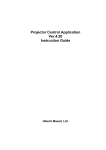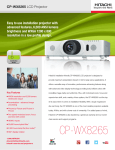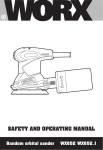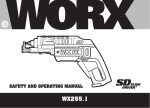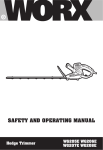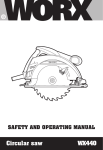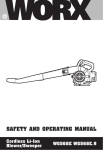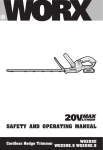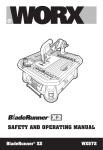Download Worx WX80RS Instruction manual
Transcript
SAFETY AND OPERATING MANUAL Reciprocating saw WX80RS General Safety Rules WARNING! Read all instructions. Failure to follow all instructions listed below may result in electric shock, fire and/ or serious injury. The term “power tool” in all of the warnings listed below refers to your mains-operated (corded) power tool or battery-operated (cordless) power tool. SAVE THESE INSTRUCTION 1.Work area 1)Keep work area clean and well lit. Cluttered or dark areas invite accidents. 2)Do not operate power tools in explosive atmospheres, such as in the presence of flammable liquids, gases or dust. Power tools create sparks which may ignite the dust or fumes. 3)Keep children and bystanders away while operating a power tool. Distractions can cause you to lose control. 2.Electrical safety 1)Power tool plugs must match the outlet. Never modify the plug in any way. Do not use any adapter plugs with earthed (grounded) power tools. Unmodified plugs and matching outlets will reduce risk of electric shock. 2)Avoid body contact with earthed or grounded surfaces, such as pipes, radiators, ranges and refrigerators. There is an increased risk of electric shock if your body is earthed or grounded. 3)Do not expose power tools to rain or wet conditions. Water entering a power tool will increase the risk of electric shock. 4)Do not abuse the cord. Never use the cord for carrying, pulling or unplugging the power tool. Keep cord away from heat, oil, sharp edges or moving parts. Damaged or entangled cords increase the risk of electric shock. 5)When operating a power tool outdoors, use an extension cord suitable for outdoor use. Use of a cord suitable for outdoor use reduces the risk of electric shock. 6)If operating a power tool in a damp Reciprocating saw location is unavoidable, use a residual current device (RCD) protected supply. Use of an RCD reduces the risk of electric shock. 3.Personal safety 1)Stay alert, watch what you are doing and use common sense when operating a power tool. Do not use a power tool while you are tired or under the influence of drugs, alcohol or medication. A moment of inattention while operating power tools may result in serious personal injury. 2)Use safety equipment. Always wear eye protection. Safety equipment such as dust mask, non-skid safety shoes, hard hat, or hearing protection used for appropriate conditions will reduce personal injuries. 3)Avoid accidental starting. Ensure the switch is in the off-position before plugging in. Carrying power tools with your finger on the switch or plugging in power tools that have the switch on invites accidents. 4)Remove any adjusting key or wrench before turning the power tool on. A wrench or a key left attached to a rotating part of the power tool may result in personal injury. 5)Do not overreach. Keep proper footing and balance at all times. This enables better control of the power tool in unexpected situations. 6)Dress properly. Do not wear loose clothing or jewellery. Keep your hair, clothing and gloves away from moving parts. Loose clothes, jewellery or long hair can be caught in moving parts. 7)If devices are provided for the connection of dust extraction and collection facilities, ensure these are connected and properly used. Use of these devices can reduce dust-related hazards. 4.Power tool use and care 1)Do not force the power tool. Use the correct power tool for your application. The correct power tool will WX80RS do the job better and safer at the rate for which it was designed. 2)Do not use the power tool if the switch does not turn it on and off. Any power tool that cannot be controlled with the switch is dangerous and must be repaired. 3)Disconnect the plug from the power source and/or the battery pack from the power tool before making any adjustments, changing accessories, or storing power tools. Such preventive safety measures reduce the risk of starting the power tool accidentally. 4)Store idle power tools out of the reach of children and do not allow persons unfamiliar with the power tool or these instructions to operate the power tool. Power tools are dangerous in the hands of untrained users. 5)Maintain power tools. Check for misalignment or binding of moving parts, breakage of parts and any other condition that may affect the power tool’s operation. If damaged, have the power tool repaired before use. Many accidents are caused by poorly maintained power tools. 6)Keep cutting tools sharp and clean. Properly maintained cutting tools with sharp cutting edges are less likely to bind and are easier to control. 7)Use the power tool, accessories and tool bits etc. in accordance with these instructions, taking into account the working conditions and the work to be performed. Use of the power tool for operations different from those intended could result in a hazardous situation. 5.Service 1)Have your power tool serviced by a qualified repair person using only identical replacement parts. This will ensure that the safety of the power tool is maintained. 2)If the replacement of the supply cord is necessary, this has to be done by the manufacturer or his agent in order to avoid a safety hazard. Reciprocating saw ADDITIONAL SAFETY RULES FOR YOUR RECIPROCATING SAW 1. Always wear a dust mask. 2. Hold power tool by insulated gripping surfaces when performing an operation where the cutting tool may contact hidden wiring or its own cord. Contact with a” live” wire will make exposed metal parts of the tool” live” and shock the operator. 3. Use clamps or another practical way to secure and support the workpiece to a stable platform. Holding the work by hand or against your body leaves it unstable and may lead to loss of control. 4. Always wear safety glasses or eye shields when using the reciprocating saw. Everyday eyeglasses have only impact-resistant lenses; they are NOT safety glasses. Following this rule will reduce the risk of serious personal injury. 5. Always wear hearing protection during extended periods of operation. Following this rule will reduce the risk of serious personal injury. 6. Keep your hands away from cutting area. Do not reach under the material being cut because the nearness of the blade to your hand is hidden from your sight. 7. Do not use dull or damaged blades. Bent blades can break easily, or cause kickback. 8. Remove the plug from the socket before carrying out any adjustment, servicing or maintenance. 9. Fully unwind cable drum extensions to avoid potential overheating. 10.When an extension cable is required you must ensure it has the correct ampere rating for your power tool and is in a safe electrical condition. 11.Ensure your mains supply voltage is the same as indicated on the rating plate. 12.Your tool is double insulated for additional protection against a possible electrical insulation failure within the tool. WX80RS 13.Always check walls, floors and ceilings to avoid hidden power cables and pipes. 14.After long working period, external metal parts and accessories could be hot. 15.Always hold the saw firmly with both hands when operating. 16.Only withdraw the blade from the cut when the blade has been stopped moving. 17.The pivoting blade foot must be held firmly against the material being cut to reduce saw vibration, blade jumping and blade breakage. 18.Before cutting, check the cutting line is free of nails, screws, etc. 19.If possible, ensure the work-piece is firmly clamped to prevent movement. 20.Never stop the cutting blade by applying side pressure to the blade. WARNING: Some dust particles created by power sawing, contain chemicals known to cause cancer, birth defects or other reproductive harm. Some examples of these chemicals are: • Lead from lead-based paints. • Crystalline silica from bricks and cement and other masonry products. • Arsenic and chromium from chemically treated lumber. Your risk from these exposures varies, depending upon how often you do this type of work. To reduce your exposure to these chemicals: • Work in a well-ventilated area. • Work with approved safety equipment, such as those dust masks that are specially designed to filter microscopic particles. Reciprocating saw SYMBOLS To reduce the risk of injury, user must read instruction manual Warning Double insulation Wear eye protection Wear ear protection Wear dust mask RCM approval mark WX80RS 4 3 5 2 1 2 6 1. On/Off Trigger Switch 2. Hand Grip Areas 3. Tool-Less Blade Clamp Lever 4. Pivoting Blade Foot 5. Blade * 6. Hex Key * Not all the accessories illustrated or described are included in standard delivery. Reciprocating saw WX80RS TECHNICAL DATA Rated voltage 220-240V~50/60Hz Rated power 800W Rated no load speed 0-2600/min Stroke length Cutting capacity max 28mm Wood (thickness) 280mm Thin pipe (diameter PVC pipe) 150mm Steel (thickness) 13mm Double insulation /II Weight 3.8kg ACCESSORIES Assorted blades (1pc for metal; 1pc for wood; 1pc for aluminium/plastic) Hex key 3pc 1pc We recommend that you purchase your accessories from the same store that sold you the tool. Use good quality accessories marked with a well-known brand name. Choose the type according to the work you intend to undertake. Refer to the accessory packaging for further details. Store personnel can assist you and offer advice. Reciprocating saw WX80RS OPERATING INSTRUCTIONS Note: Before using the tool, read the instruction book carefully. 1. ON/OFF SWITCH Depress the button to start and release it to stop your tool. 2. VARIABLE SPEED CONTROL Your tool is equipped with a variable speed controlled trigger switch. The tool can be turned “ON” or “OFF” by squeezing or releasing the trigger. The blade plunger stroke rate can be adjusted from the minimum to maximum by the pressure you apply to the trigger. Apply more pressure to increase the speed and release pressure to decrease speed (See A) A 3. HAND GRIP AREAS Always hold your saw firmly with both hands when operating (See A). 4. TOOL-LESS BLADE FITTING To install the blade (See Fig B and Fig C), disconnect the saw from power supply. If necessary, extend the pivoting blade foot away from the blade clamp for easier access. Pull the tool-less blade clamp lever (3) up with your thumb, as shown. Insert the blade into the saw’s blade clamp and make sure that the blade attaches to the blade pin inside the clamp. Push down blade clamp lever (3) ensure the blade is locked securely in place. To remove Blade (See Fig B and Fig C) Disconnect saw from power supply. If necessary, extend the pivoting blade foot away from the blade clamp for easier access. First, pull the blade clamp lever (3) up with your thumb, and then pull the blade out of the blade clamp. 5. PIVOTING BLADE FOOT ADJUSTMENT If you need to reduce the cutting capacity of your tool the pivoting blade foot (4) may be adjusted as follows: Using the hex key provided, loosen the two screws on the underside of the front housing (See Fig D). Slide the pivoting blade foot to give the required distance from the end of the blade (See Fig D) to the pivoting blade foot (This distance equals new cutting capacity). Then securely tighten both screws. The pivoting blade foot slide is now locked but the pivoting blade foot will continue to pivot, as it must Reciprocating saw 3 B C D WX80RS follow your work surface. 6. PIVOTING BLADE FOOT The pivoting blade foot must be held firmly against the material being cut to reduce saw vibration, blade jumping and blade breakage. E F G H1 7. FLUSH CUTTING It is possible to make cuts extremely close to floors, walls and other difficult areas. Insert the blade shank into the blade clamp with the blade teeth facing up (opposite to normal working position). This will make cuts closer to the work surface (See Fig E). Using special flexible blades insert the blade into the blade clamp with the blade teeth facing down (normal working position). It will allow flush pipe cutting (See Fig F). 8. WOOD CUTTING Always ensure the work-piece is firmly clamped to prevent movement. For easier control use low speed to start cutting, then increase to the correct speed (See Fig G). 9. METAL CUTTING This saw has different metal cutting capacities depending upon the type of blade being used and metal being cut. ALWAYS clamp the work down to prevent it from slipping. Use a finer blade for ferrous metals and a coarse blade for non-ferrous metals. When cutting thin gauge sheet metals, ALWAYS clamp wood on both sides of the sheet. This will give you a clean cut without excess vibration or tearing of the metal. DO NOT force the cutting blade. Forcing the blade will reduce blade life and cause the blade to break. NOTE: We recommend that you spread a thin film of oil or other coolant along the line of cut ahead of the saw. This will allow easier operation and help extend blade life. When cutting aluminum, use kerosene. 10. POCKET CUTTING (Soft materials only) Mark the pocket or internal hole to be cut out. Insert the special cutting blade with blade teeth facing down and clamp securely. Angle the saw so that the back edge of the blade guard is resting on the work surface (See Fig H.1 and Fig H.2). Use a slow speed to start the cut to avoid breaking the blade but increase to correct Reciprocating saw WX80RS speed once the cut has started. With the blade guard held firmly against the work surface, start a slow but controlled upward swing of the saw. The blade will cut into and through the material. Always ensure the blade is completely through the material before cutting the remainder of the pocket. WORK HINTS FOR YOUR RECIPROCATING SAW H2 If your power tool becomes too hot, set the speed to maximum and run a no load for 2-3 minutes to cool the motor. Always ensure the work-piece is firmly held or clamped to prevent movement. The blade guard must be held firmly against the material being cut to reduce saw vibration, blade jumping and blade breakage. MAINTENANCE Remove the plug from the socket before carrying out any adjustment, servicing or maintenance. Your power tool requires no additional lubrication or maintenance. There are no user serviceable parts in your power tool. Never use water or chemical cleaners to clean your power tool. Wipe clean with a dry cloth. Always store your power tool in a dry place. Keep the motor ventilation slots clean. Keep all working controls free of dust. Occasionally you may see sparks through the ventilation slots. This is normal. If the supply cord is damaged, it must be replaced by the manufacturer, its service agent or similarly qualified persons in order to avoid a hazard. Reciprocating saw WX80RS Copyright © 2011, Positec. All Rights Reserved.












